Generation of Subdiffraction Optical Needles by Simultaneously Generating and Focusing Azimuthally Polarized Vortex Beams through Pancharatnam–Berry Metalenses
Abstract
:1. Introduction
2. Theory and Designs of Metalens
2.1. Theoretical Study on Focusing the Azimuthally Polarized Vortex Beam
2.2. Design of Metalens
3. Results and Discussions
3.1. Generating and Focusing the Azimuthally Polarized Vortex Beam with the Metalens
3.2. The Needle Beam Generated by BOE with Metalens
3.3. The Needle Beam Generated by an Annular Aperture with Metalens
4. Conclusions
Supplementary Materials
Author Contributions
Funding
Institutional Review Board Statement
Informed Consent Statement
Data Availability Statement
Acknowledgments
Conflicts of Interest
References
- Zhan, Q.W.; Leger, J.R. Focus shaping using cylindrical vector beams. Opt. Express 2002, 10, 324–331. [Google Scholar] [CrossRef] [PubMed]
- Dorn, R.; Quabis, S.; Leuchs, G. Sharper focus for a radially polarized light beam. Phys. Rev. Lett. 2003, 91, 233901. [Google Scholar] [CrossRef] [PubMed]
- Yang, J.M.; Gong, L.; Shen, Y.C.; Wang, L.H.V. Synthetic Bessel light needle for extended depth-of-field microscopy. Appl. Phys. Lett. 2018, 113, 181104. [Google Scholar] [CrossRef] [PubMed]
- Kant, R. Wavefront engineering: Selective aperture illumination for increased depth of focus and super-resolution for photolithography. J. Mod. Opt. 2015, 62, 1115–1125. [Google Scholar] [CrossRef]
- Li, Y.C.; Xin, H.B.; Lei, H.X.; Liu, L.L.; Li, Y.Z.; Zhang, Y.; Li, B.J. Manipulation and detection of single nanoparticles and biomolecules by a photonic nanojet. Light Sci. Appl. 2016, 5, e16176. [Google Scholar] [CrossRef] [PubMed]
- Wang, H.; Shi, L.; Lukyanchuk, B.; Sheppard, C.; Chong, C.T. Creation of a needle of longitudinally polarized light in vacuum using binary optics. Nat. Photonics 2008, 2, 501–505. [Google Scholar] [CrossRef]
- Huang, K.; Shi, P.; Kang, X.; Zhang, X.; Li, Y. Design of DOE for generating a needle of a strong longitudinally polarized field. Opt. Lett. 2010, 35, 965–967. [Google Scholar] [CrossRef] [PubMed]
- Man, Z.S.; Min, C.J.; Du, L.P.; Zhang, Y.Q.; Zhu, S.W.; Yuan, X.C. Sub-wavelength sized transversely polarized optical needle with exceptionally suppressed side-lobes. Opt. Express 2016, 24, 874–882. [Google Scholar] [CrossRef] [PubMed]
- Hao, X.; Kuang, C.; Wang, T.; Liu, X. Phase encoding for sharper focus of the azimuthally polarized beam. Opt. Lett. 2010, 35, 3928–3930. [Google Scholar] [CrossRef] [PubMed]
- Guan, J.; Lin, J.; Chen, C.; Ma, Y.; Tan, J.; Jin, P. Transversely polarized sub-diffraction optical needle with ultra-long depth of focus. Opt. Commun. 2017, 404, 118–123. [Google Scholar] [CrossRef]
- Liu, L.; Shi, L.; Li, F.; Yu, S.; Yan, W. Generation of an ultra-long optical needle induced by an azimuthally polarized beam. IEEE Photonics J. 2020, 13, 1–12. [Google Scholar] [CrossRef]
- Lalithambigai, K.; Anbarasan, P.M.; Rajesh, K.B. Formation of optical needle by high NA lens axicon with dedicated complex spiral phase mask. Opt. Quantum Electron. 2015, 47, 2017–2025. [Google Scholar] [CrossRef]
- Khorasaninejad, M.; Chen, W.T.; Devlin, R.C.; Oh, J.; Zhu, A.Y.; Capasso, F. Metalenses at visible wavelengths: Diffraction-limited focusing and subwavelength resolution imaging. Science 2016, 352, 1190–1194. [Google Scholar] [CrossRef] [PubMed] [Green Version]
- Shen, Z.; Li, R.; Xue, Y.Z.; Qiu, Z.Y.; Xiang, Z.Y.; Zhou, J.Y.; Zhang, B.F. Generation of optical vortices with polarization-insensitive metasurfaces. IEEE Photonics J. 2020, 12, 1–10. [Google Scholar] [CrossRef]
- Ma, H.F.; Wang, G.Z.; Kong, G.S.; Cui, T.J. Broadband circular and linear polarization conversions realized by thin birefringent reflective metasurfaces. Opt. Mater. Express 2014, 4, 1717–1724. [Google Scholar] [CrossRef]
- Zang, X.; Xu, W.; Gu, M.; Yao, B.; Chen, L.; Peng, Y.; Xie, J.; Balakin, A.V.; Shkurinov, A.P.; Zhu, Y.; et al. Polarization-insensitive metalens with extended focal depth and longitudinal high-tolerance imaging. Adv. Opt. Mater. 2019, 8, 1901342. [Google Scholar] [CrossRef]
- Shen, Z.; Li, R.; Huang, S.; Zhang, B.; Chen, Q. Generation of needle beams through focusing of azimuthally polarized vortex beams by polarization-insensitive metasurfaces. J. Opt. Soc. Am. B 2021, 38, 1869–1876. [Google Scholar] [CrossRef]
- Yu, P.; Chen, S.; Li, J.; Cheng, H.; Li, Z.; Liu, W.; Xie, B.; Liu, Z.; Tian, J. Generation of vector beams with arbitrary spatial variation of phase and linear polarization using plasmonic metasurfaces. Opt. Lett. 2015, 40, 3229–3232. [Google Scholar] [CrossRef]
- Zhao, R.; Huang, L.; Tang, C.; Li, J.; Li, X.; Wang, Y.; Zentgraf, T. Nanoscale polarization manipulation and encryption based on dielectric metasurfaces. Adv. Opt. Mater. 2018, 6, 1800490. [Google Scholar] [CrossRef] [Green Version]
- Arbabi, A.; Horie, Y.; Bagheri, M.; Faraon, A. Dielectric metasurfaces for complete control of phase and polarization with subwavelength spatial resolution and high transmission. Nat. Nanotechnol. 2015, 10, 937. [Google Scholar] [CrossRef]
- Zhang, F.; Yu, H.; Fang, J.; Zhang, M.; Chen, S.; Wang, J.; He, A.; Chen, J. Efficient generation and tight focusing of radially polarized beam from linearly polarized beam with all-dielectric metasurface. Opt. Express 2016, 24, 6656–6664. [Google Scholar] [CrossRef] [PubMed] [Green Version]
- Zuo, R.; Liu, W.; Cheng, H.; Chen, S.; Tian, J. Breaking the diffraction limit with radially polarized light based on dielectric metalenses. Adv. Opt. Mater. 2018, 6, 1800795. [Google Scholar] [CrossRef]
- Devlin, R.C.; Khorasaninejad, M.; Chen, W.T.; Oh, J.; Capasso, F. Broadband high-efficiency dielectric metasurfaces for the visible spectrum. Proc. Natl. Acad. Sci. USA 2016, 113, 10473–10478. [Google Scholar] [CrossRef] [PubMed] [Green Version]
- Chen, W.T.; Zhu, A.Y.; Khorasaninejad, M.; Shi, Z.; Sanjeev, V.; Capasso, F. Immersion meta-lenses at visible wavelengths for nanoscale imaging. Nano Lett. 2017, 17, 3188–3194. [Google Scholar] [CrossRef]
- Youngworth, K.; Brown, T. Focusing of high numerical aperture cylindrical-vector beams. Opt. Express 2000, 7, 77–87. [Google Scholar] [CrossRef]
- Lin, J.; Zhao, H.; Ma, Y.; Tan, J.; Jin, P. New hybrid genetic particle swarm optimization algorithm to design multi-zone binary filter. Opt. Express 2016, 24, 10748. [Google Scholar] [CrossRef] [PubMed]
- Schonbrun, E.; Seo, K.; Crozier, K.B. Reconfigurable imaging systems using elliptical nanowires. Nano Lett. 2011, 11, 4299. [Google Scholar] [CrossRef]
- Guo, H.; Weng, X.; Jiang, M.; Zhao, Y.; Sui, G.; Hu, Q.; Wang, Y.; Zhuang, S. Tight focusing of a higher-order radially polarized beam transmitting through multi-zone binary phase pupil filters. Opt. Express 2013, 21, 5363–5372. [Google Scholar] [CrossRef] [PubMed]
- Bomzon, Z.; Min, G.; Shamir, J. Angular momentum and geometrical phases in tight-focused circularly polarized plane waves. Appl. Phys. Lett. 2006, 89, 241104. [Google Scholar] [CrossRef]

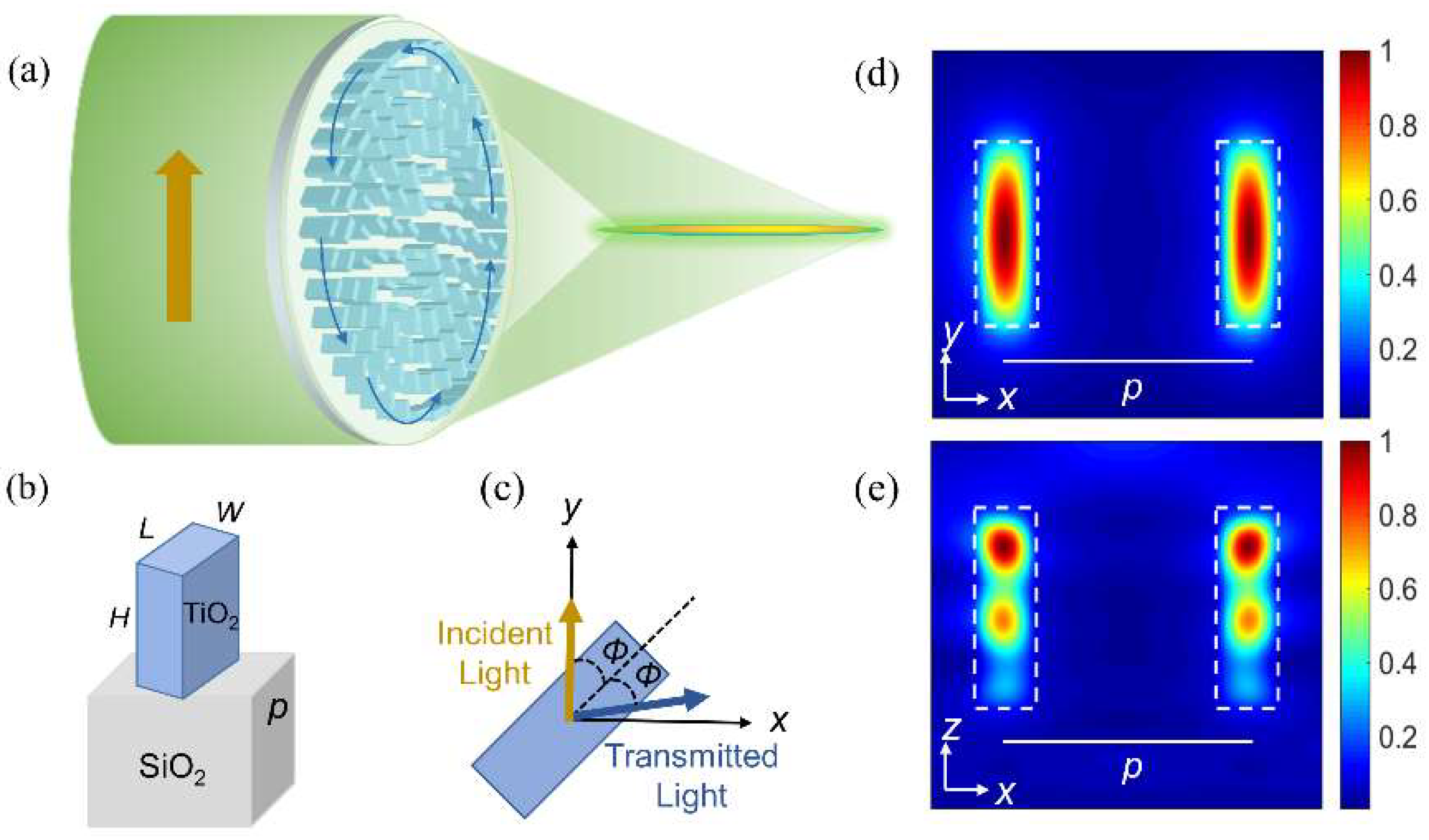
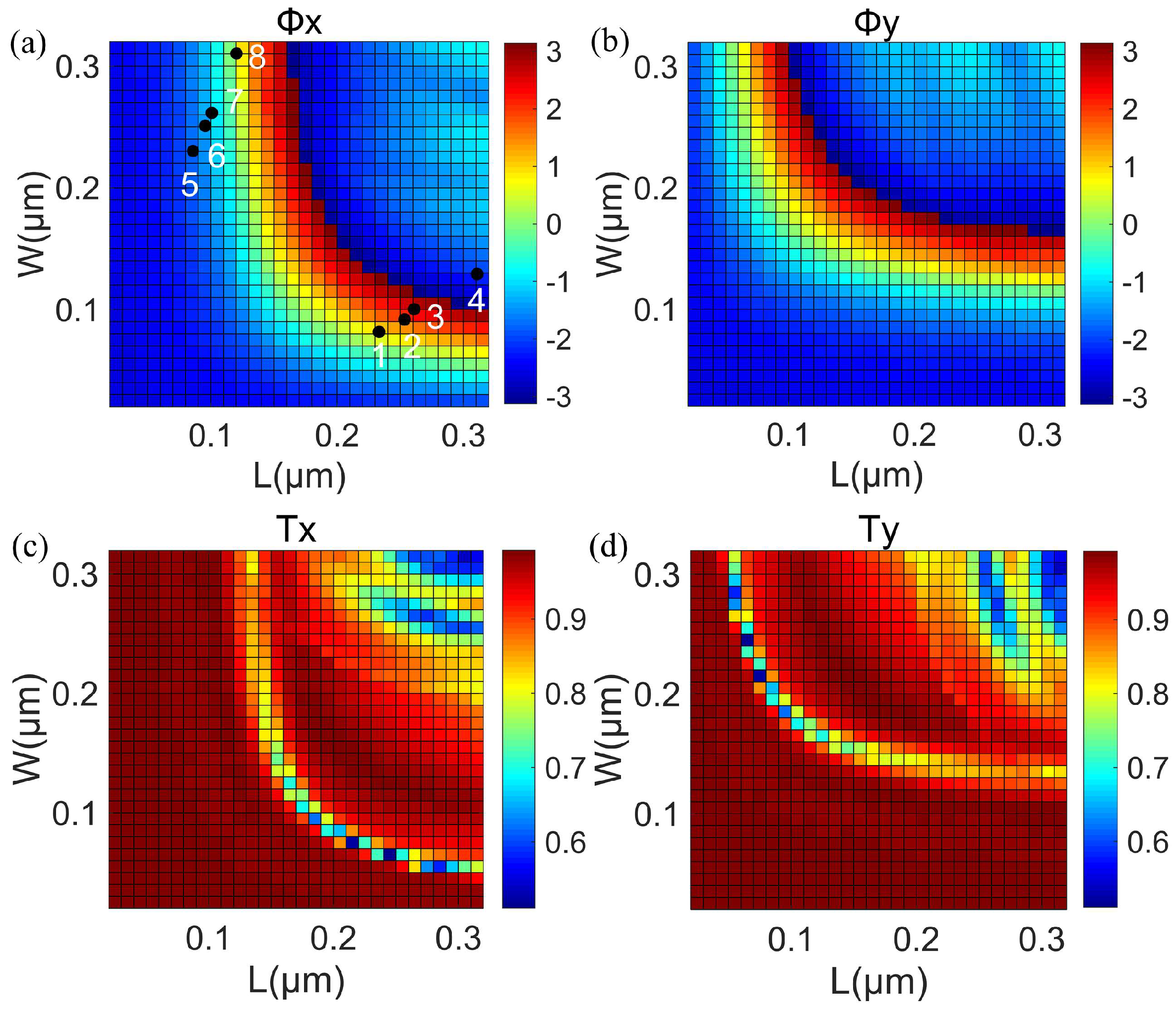
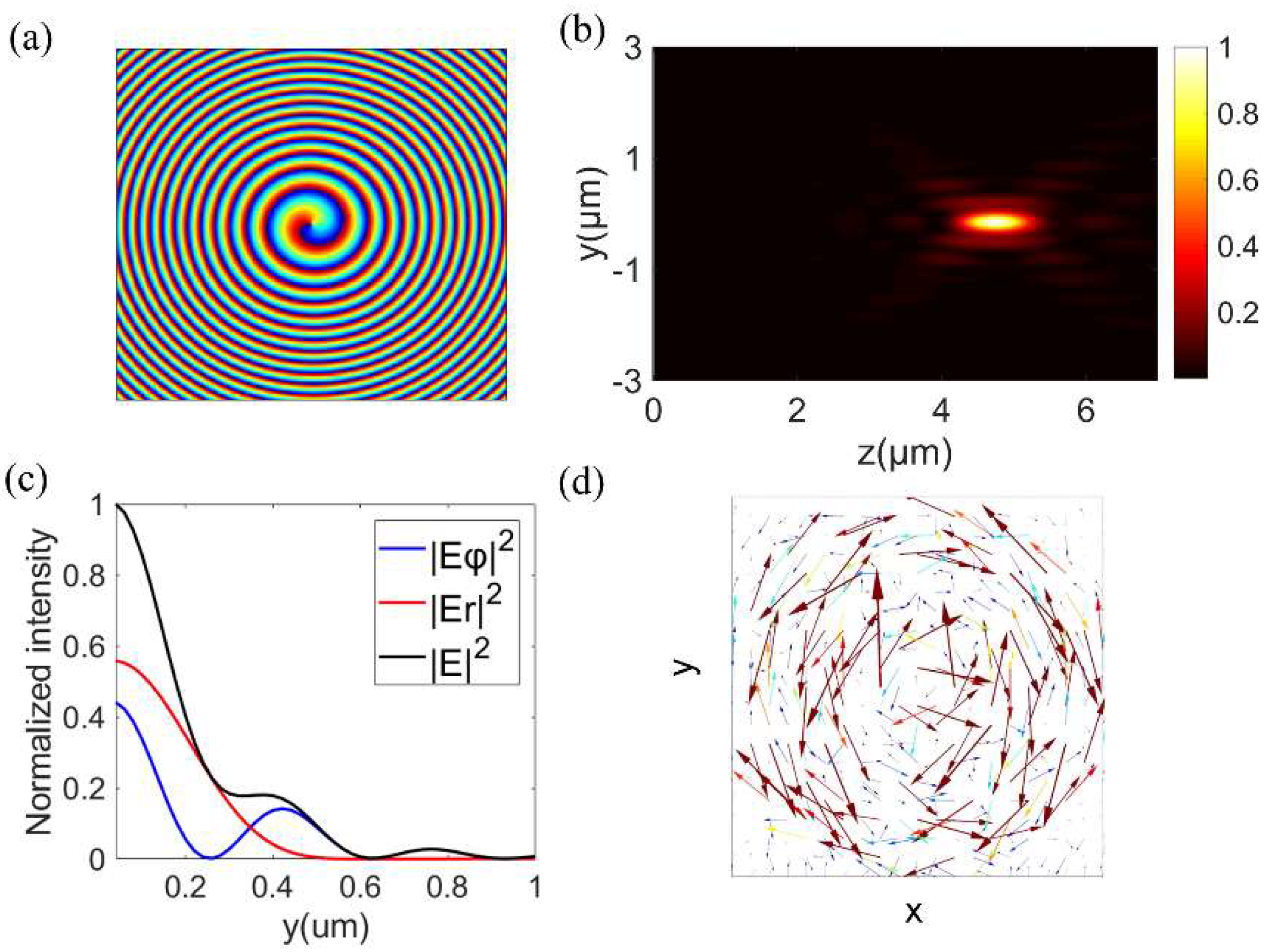
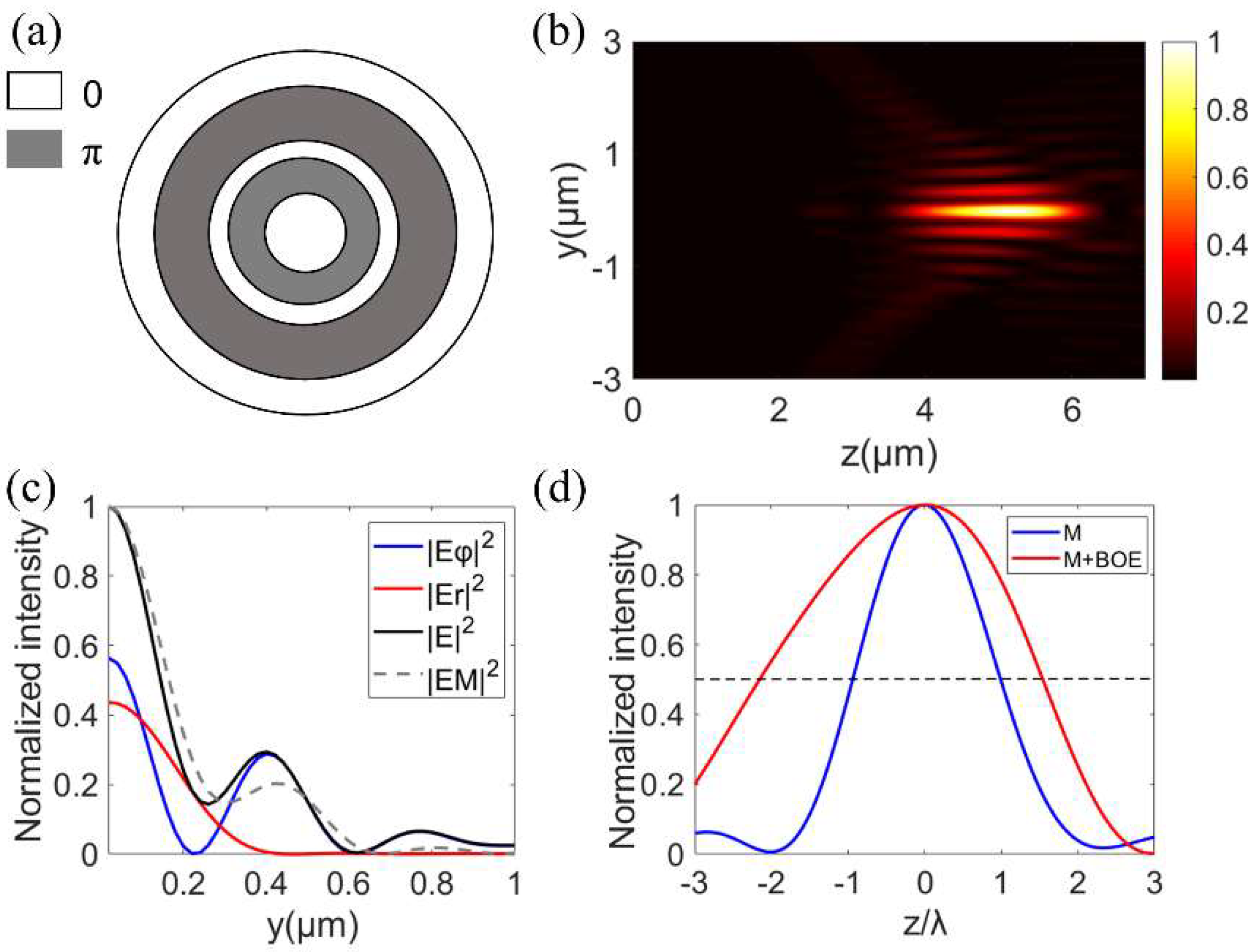
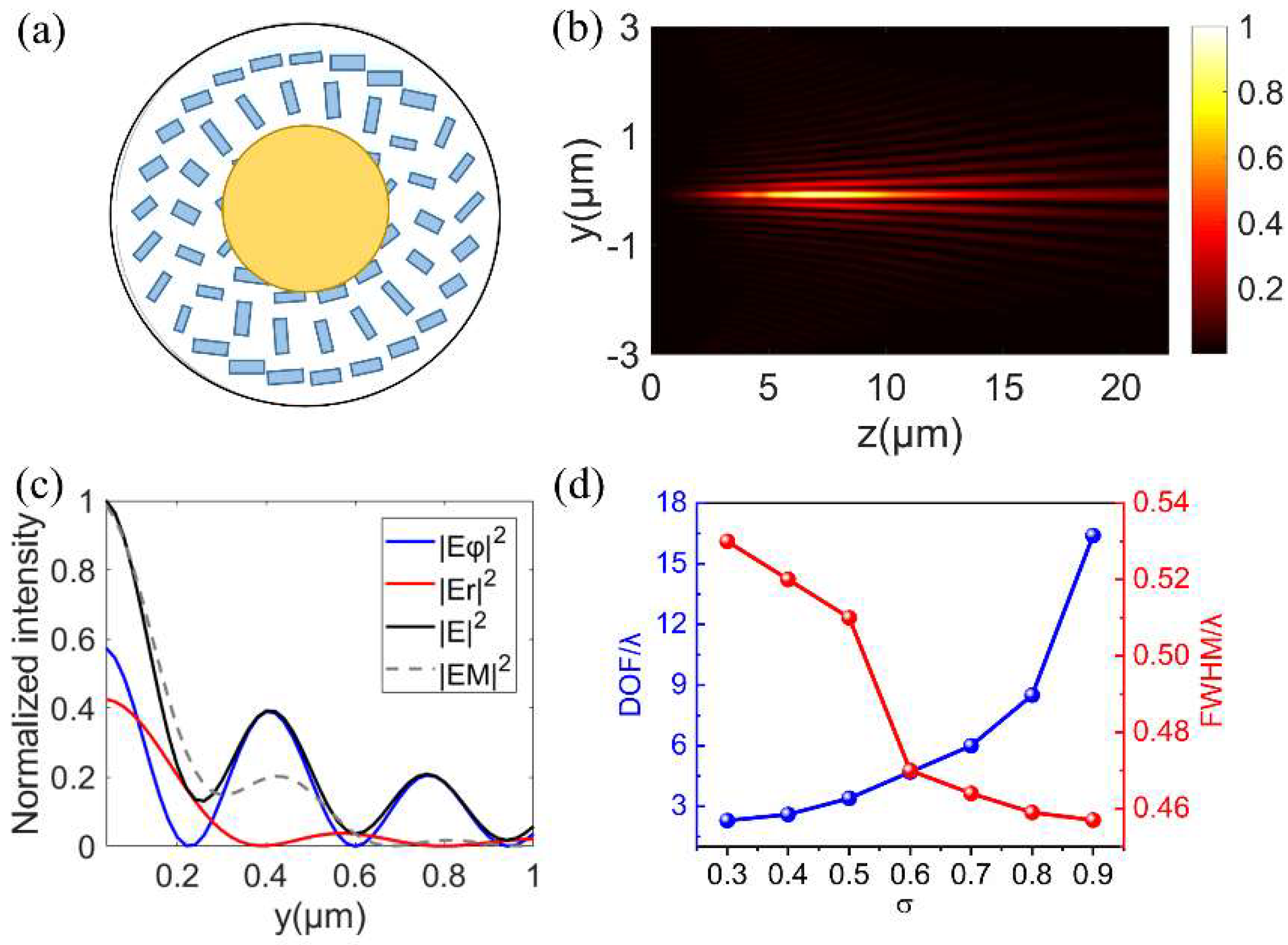
Publisher’s Note: MDPI stays neutral with regard to jurisdictional claims in published maps and institutional affiliations. |
© 2022 by the authors. Licensee MDPI, Basel, Switzerland. This article is an open access article distributed under the terms and conditions of the Creative Commons Attribution (CC BY) license (https://creativecommons.org/licenses/by/4.0/).
Share and Cite
Shen, Z.; Huang, S. Generation of Subdiffraction Optical Needles by Simultaneously Generating and Focusing Azimuthally Polarized Vortex Beams through Pancharatnam–Berry Metalenses. Nanomaterials 2022, 12, 4074. https://doi.org/10.3390/nano12224074
Shen Z, Huang S. Generation of Subdiffraction Optical Needles by Simultaneously Generating and Focusing Azimuthally Polarized Vortex Beams through Pancharatnam–Berry Metalenses. Nanomaterials. 2022; 12(22):4074. https://doi.org/10.3390/nano12224074
Chicago/Turabian StyleShen, Zhe, and Shijie Huang. 2022. "Generation of Subdiffraction Optical Needles by Simultaneously Generating and Focusing Azimuthally Polarized Vortex Beams through Pancharatnam–Berry Metalenses" Nanomaterials 12, no. 22: 4074. https://doi.org/10.3390/nano12224074
APA StyleShen, Z., & Huang, S. (2022). Generation of Subdiffraction Optical Needles by Simultaneously Generating and Focusing Azimuthally Polarized Vortex Beams through Pancharatnam–Berry Metalenses. Nanomaterials, 12(22), 4074. https://doi.org/10.3390/nano12224074






